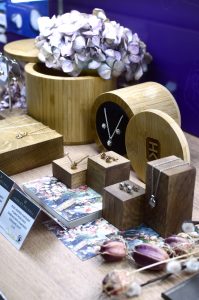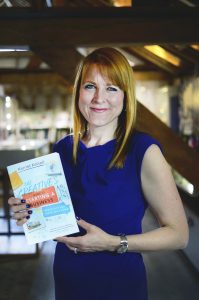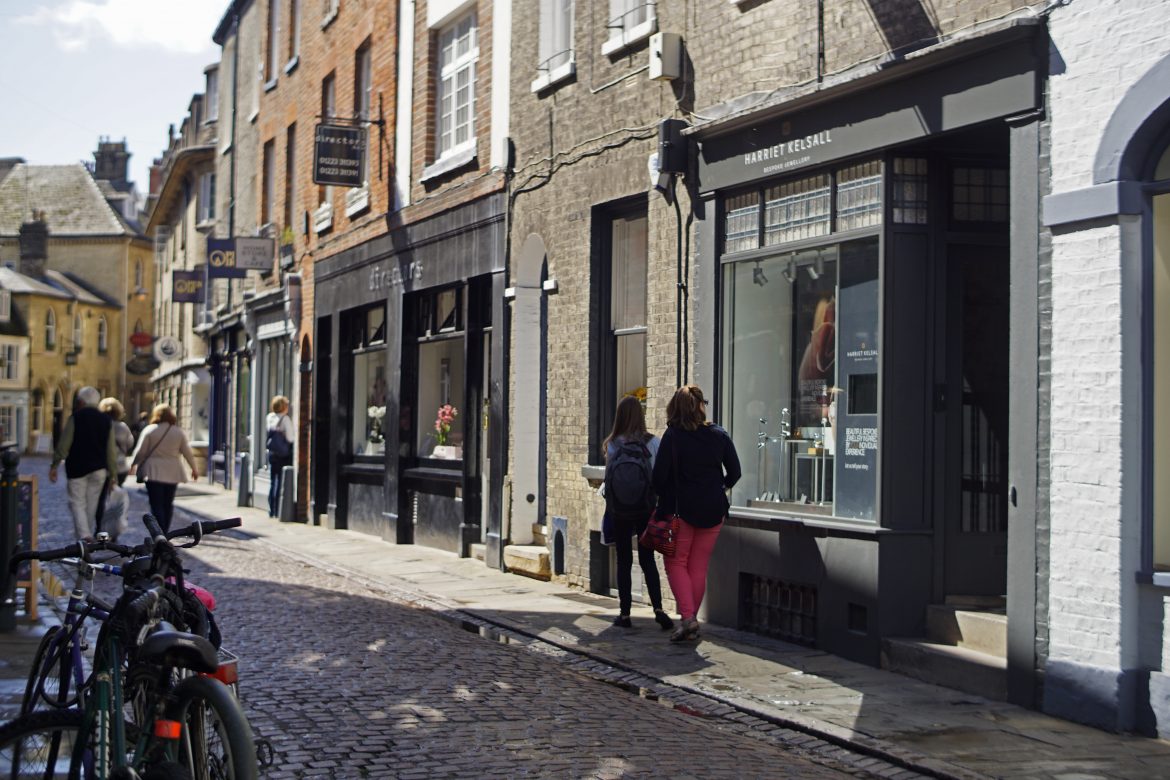Jewellery shop owner and author Harriet Kelsall tells Edition about the keys to her success
Words by Charlotte Griffiths
If you’ve strolled down Green Street at any point in the last 15 years, chances are that your eyes will have been caught by the sparkling jewellery proudly displayed by Harriet Kelsall and her team of jewellers who have called this street home since 2005. Specialising in the creation of bespoke rings and jewellery from three stores – one in Cambridge, one near Hitchin and one in London’s Primrose Hill, as well as a well-maintained online shop – Harriet’s a big fan of her Cambridge branch. “We love it here,” she smiles. “I’ve always loved Cambridge – I’ve got a real soft spot for the whole city. I really like the fact that you’ve got the traditional aspects of the university and the history, and yet there’s all this cutting-edge technology, and what’s going on with science and education – it’s so exciting.”
Harriet herself grew up in St Albans and has spent most of her life living in the countryside, which worked well while her children were little. But now they’re older – 14 and 10 – a recent full-time move into Cambridge has seen the whole family enthusiastically embracing city living. She sees strong parallels between the unique pieces created by her team of jewellers and that blend of the historical and the contemporary that she loves about our city.

“We’re creating very traditional symbols for people, and sometimes people choose traditional designs for their jewellery. But we also very much embrace modern technology – where we make our jewellery, in our workshop just down the road in North Hertfordshire, we have video links between stores, special microscopes so our designers can see what’s going on in the workshops. We use a lot of technology that our clients may not be aware of, but it’s what makes our approach work,” she says.
Harriet started her jewellery business back in 1998, from her kitchen table. Like most people going it alone, she had to turn her own hand to all the tasks required to build her company. “It was a juggle, but a different kind of juggle: I was doing everything,” she says. “I was making the jewellery by myself, setting the stones myself a lot of the time, polishing the jewellery myself – having design consultations by myself, writing the website myself and trying to do desktop publishing myself.”
One of the contributing factors to Harriet’s rise to success was her background in the computer industry and her insistence on having a digital presence for the brand from the off. “Even though I’d been making jewellery as well, I was quite aware of technology and quite ‘techy’ – so when I set out, even back in 1996, I had a website,” she said. “It was very basic, you know, just a couple of pictures. And it said ‘I can make jewellery, especially for you, to order’ – because that was my niche.” At that time, as one of the only jewellers on the internet, Harriet’s work attracted the interest of the other early adopters who were able to access the proto web. “Doctors, architects and teachers were the three main groups of people who were my customers – because they were the people that were using the internet back then,” she smiles.
It was Harriet’s nous for digital marketing that led to the business setting up a bricks-and-mortar shop on Green Street in Cambridge. “Back then we were very reliant on the internet: the site was really well optimised, and we were number one for the search term ‘engagement rings’ at the time – we’re not now, obviously, because things have changed – and work was just coming in, the internet had gone crazy; we had so much work that we couldn’t cope with it. Then one day Google – who I now know were getting ready to list and to be sold – decided to get people to buy the top spaces on search results. So I came into work one day and we’d gone from being number one on the search for engagement rings to being on page 68 for engagement rings – and I suddenly thought, ‘Bloody hell, you know, here we are completely with all our eggs in one basket’.”
Despite Harriet Kelsall having had a website before Google even existed, the business’s success was completely at the search engine’s mercy. “We realised we needed bricks and mortar, because we needed passing trade – but we also wanted to stay optimised in an important centre.” Harriet and her team had noticed quite a few customers were from Cambridge, and at the time it felt more financially achievable than setting up in London. “So we opened this store on Green Street as a way of making sure that we didn’t have all our eggs in that basket – and we’re so glad we did,” says Harriet.
“The business’s success was completely at Google’s mercy”
The variety of creative challenges presented by her Cambridge clients is what excites Harriet and her team about the location. “It’s such an exciting place to have a shop – you never know who’s going to come in the door,” she says. “You have scientists coming in saying they want something that’s inspired by DNA, or some amazing technical concept that we have to try and get our heads round – and then in the next minute, we’ve somebody who wants that ring to be inspired by magic, or something very natural – it’s fascinating.”
Over the past 15 years of working with locals to create their own bespoke engagement rings and pieces of jewellery, the designers have noticed a bit of a trend. “We’ve found that people in Cambridge very much embrace stories, and the symbolism that’s behind designs,” Harriet explains. “They tend to think quite a lot, and be quite interested in the process, and how we’re doing what we’re doing by hand – we draw our designs by hand here, which is unusual – and we also make photobooks of the process of the jewellery being made. Our clients love the story of the making process almost as much as they love the story behind their own jewellery.”
Resetting stones and creating new jewellery from old pieces is another aspect of the business that Harriet loves. “It’s glamorous recycling,” she grins. “We do a lot of that – people come in all the time with jewellery they’ve inherited, or something they just don’t like anymore. There’s a story I often tell about a girl who came in with a pile of awful, horrid, cheap nine-carat gold jewellery – a lot of gold – and she said: ‘These are all the presents that my lying, cheating bastard of a boyfriend bought me, and I want you to melt them down while I watch.’ Okay – so we did that!” Harriet laughs. “We made this really chunky dress ring with Roman numerals of her birth dates, symbolising that she could make her own decisions. And then she came back a couple of years later with the right bloke, and we made her a beautiful big diamond engagement ring, and a wedding ring – and she’s very happy. It’s all good. But it was very funny and yes, sometimes redesigning jewellery really does feel like therapy.”
As well as overseeing her three stores, Harriet is currently chair of the National Association of Jewellers, the main trade association for professional jewellers working in the UK, and has been involved for nearly nine years – becoming the first female chair almost two years ago. Harriet is also a non-executive director on the British Hallmarking Council, an executive non-departmental public body involved in enforcing hallmarking law, maintaining standards and supporting the Assay Offices – the bodies who ensure the purity of precious metals. This task is one she’s relished, and found particularly interesting in relation to the uncertainties surrounding Brexit. “We’re just working with one Act, which is the Hallmarking Act – and the amount of work involved in separating us from the EU is just phenomenal,” she says. “We’ve got all of this mutual recognition of marks – and some countries are saying it’s fine, we’ll just carry on, but a lot of countries are saying no. For example, Ireland has said they will no longer recognise our hallmarks, which is just…” she trails off. “Lots of our members – for example, manufacturers in Britain who are making jewellery and selling it to Ireland – have now got to jump through loads of extra hoops in order to get their products recognised. And in the great scheme of things, this is just this tiny Act, which is causing so much upheaval that you start to get a vague awareness of the enormity of the task.”
“Harriet has a full schedule of extracurricular activities”
With such high-profile contributions to her industry, three stores and still the occasional jewellery commission to get her teeth into – what’s Harriet’s secret to managing her time? “I’m not sure I entirely do manage it,” she laughs. “The main thing is that the team in the company, both here in Cambridge and across the business, are brilliant. I know that I can always lean on them as much as I need to, and if I ever need to lean on them more than that, they’re there. I think I’m also good at delegating because I’m dyslexic – it’s a real advantage in business. It means you’re good at trusting other people to do things that you know they can do, and you’re really bad at thinking about just one thing at a time – you’re really good at thinking about lots of things at a time, which is a skillset that works really well for doing what I do. I’m good at not getting too sucked into the detail, and keeping an overview and trying to keep everything going – I hope,” she laughs.
When she does get time off, Harriet has a packed schedule of extracurricular activities, including running along the river, singing with the Lucy Cavendish Singers, salsa dancing and exploring the many restaurants around the city. “My favourite’s probably still La Mimosa – I love the people there – and we’re all quite excited to try the new Spanish one on Green Street [Mercado Central],” she enthuses.
Harriet is also a published author: her first book, The Creative’s Guide to Starting a Business, won her wide acclaim, and she has plans to write a second at some point soon. “I think it would be interesting to examine creative entrepreneurship and the real innovators, and how dyslexic people fit into that world – but I can’t quite put my finger on it at the moment,” she says.

“I think one of the things that separates a successful entrepreneur from a less successful entrepreneur is that we just don’t give up. When there’s a problem, like when something doesn’t work, people don’t like our products – whatever it is – a lot of people go, ‘well, obviously I’m not cut out for this: I’m really glad I gave it a try, but I’m going to back off now’. Whereas we will just say, ‘Oh, that’s not worked: how can I make it work?’ and then we’ll try something else, and if it still doesn’t work, we think: ‘how can I make it work until it works?’. It’s just this kind of relentless resilience: I’m going to make this work, because I can see it working, so I know it will work.”
And whatever it is that fills the time freed up when Harriet finishes her term as chair of the National Association of Jewellers will undoubtedly receive the same level of determined application – as all the projects that this dedicated business woman has turned her hand to.
“It’s funny thinking back to the beginning of the business, because you do forget quite how you were feeling,” she says. “You can explain to people that there was this trajectory, and this happened – but of course, at the time, you’re just flying by the seat of your pants, you’ve got no idea whether you’re doing the right thing or not, and you’re hoping that it will work out – you keep making mistakes, but crucially, you just don’t give up.”

